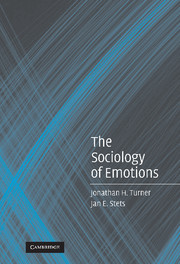Book contents
- Frontmatter
- Contents
- Tables and Figures
- Acknowledgment
- Foreword by Lynn Smith-Lovin
- 1 Conceptualizing Emotions Sociologically
- 2 Dramaturgical and Cultural Theorizing on Emotions
- 3 Ritual Theorizing on Emotions
- 4 Symbolic Interactionist Theorizing on Emotions
- 5 Symbolic Interactionist Theorizing on Emotions with Psychoanalytic Elements
- 6 Exchange Theorizing on Emotions
- 7 Structural Theorizing on Emotions
- 8 Evolutionary Theorizing on Emotions
- 9 Prospects for the Sociology of Emotions
- References
- Index
6 - Exchange Theorizing on Emotions
Published online by Cambridge University Press: 05 June 2012
- Frontmatter
- Contents
- Tables and Figures
- Acknowledgment
- Foreword by Lynn Smith-Lovin
- 1 Conceptualizing Emotions Sociologically
- 2 Dramaturgical and Cultural Theorizing on Emotions
- 3 Ritual Theorizing on Emotions
- 4 Symbolic Interactionist Theorizing on Emotions
- 5 Symbolic Interactionist Theorizing on Emotions with Psychoanalytic Elements
- 6 Exchange Theorizing on Emotions
- 7 Structural Theorizing on Emotions
- 8 Evolutionary Theorizing on Emotions
- 9 Prospects for the Sociology of Emotions
- References
- Index
Summary
In exchange theories, interaction is a process of giving and receiving valued resources. An individual gives up resources to receive resources that are viewed as more valued, thereby earning a “profit” from the exchange. Exchange theories owe their inspiration to two branches of social science: behavioristic psychology and neoclassical economics. Within the behavioristic tradition, organisms are conceptualized as reward seeking and punishment avoiding. As a consequence of this propensity, animals will emit behaviors that bring rewards or positive reinforcement and avoid behaviors that bring punishments or negative reinforcement. Those behaviors that have brought rewards in the past will be repeated; if the receipt of rewards has been associated with a particular stimulus, the presence of this or a similar stimulus will initiate the same behaviors that in the past were reinforced. Repetition of behaviors will continue until they no longer bring rewards. The more an organism has received rewards of a given kind in the recent past, the less valuable will additional increments of these rewards be as the organism becomes “satiated” with a particular type of reward.
The original program in behaviorism avoided the “black box” of human cognition, preferring instead to study observable stimuli and behaviors (Skinner, 1938, 1953; Watson, 1913). For such a program to be of interest to sociologists, however, the original restrictions on studying only directly observable behaviors had to be compromised.
- Type
- Chapter
- Information
- The Sociology of Emotions , pp. 179 - 214Publisher: Cambridge University PressPrint publication year: 2005

